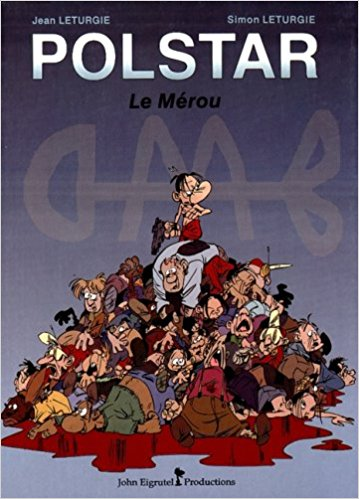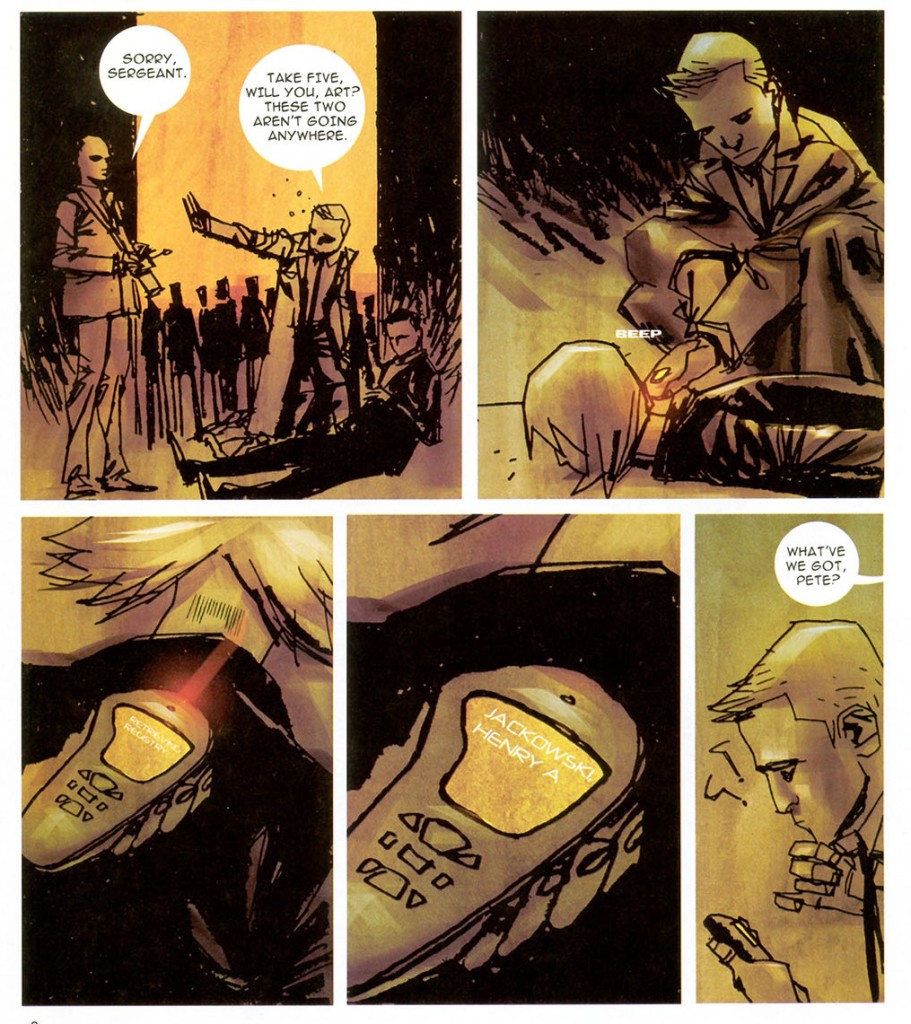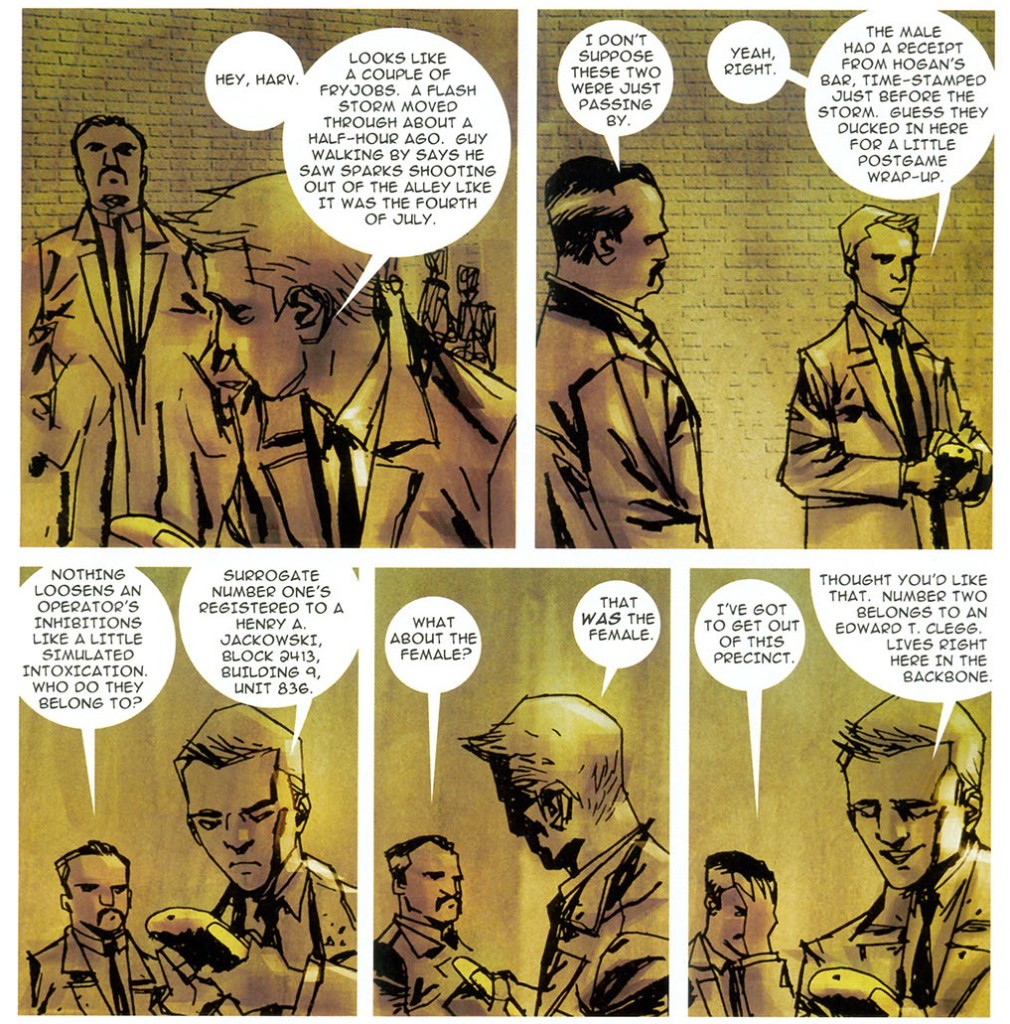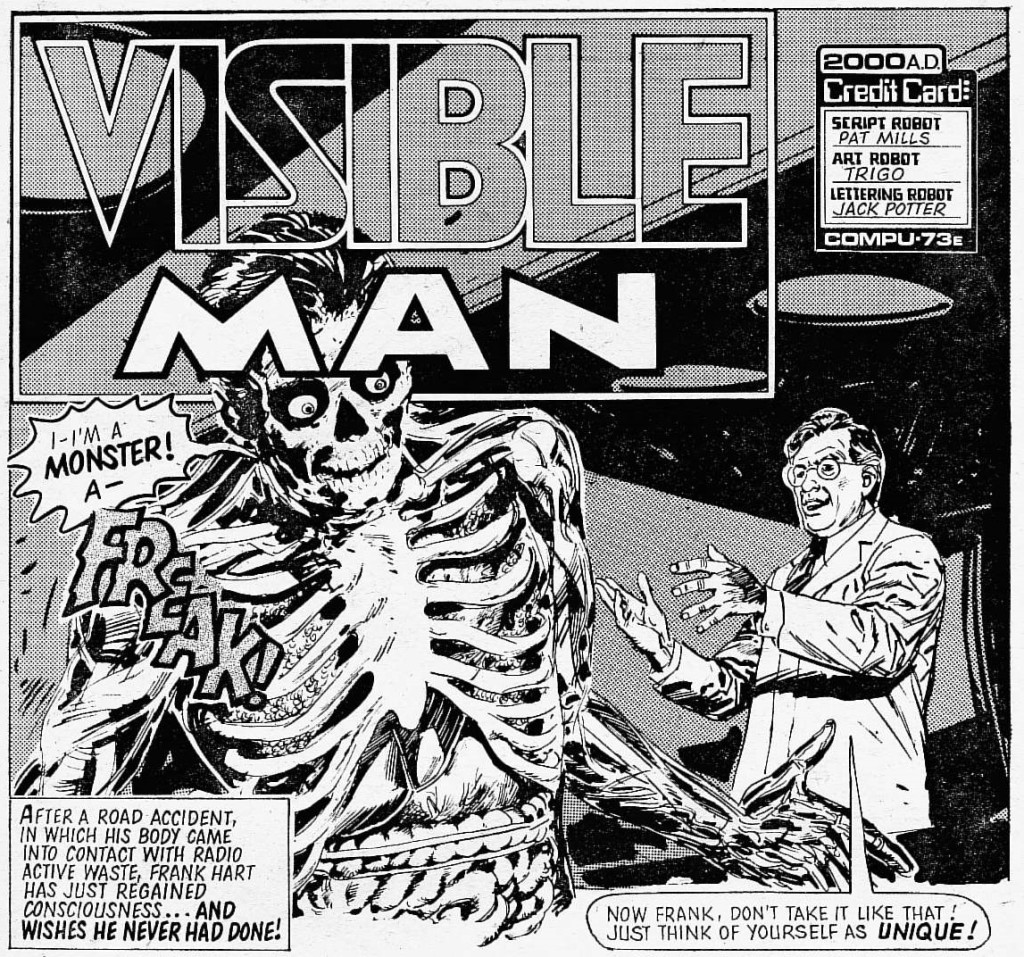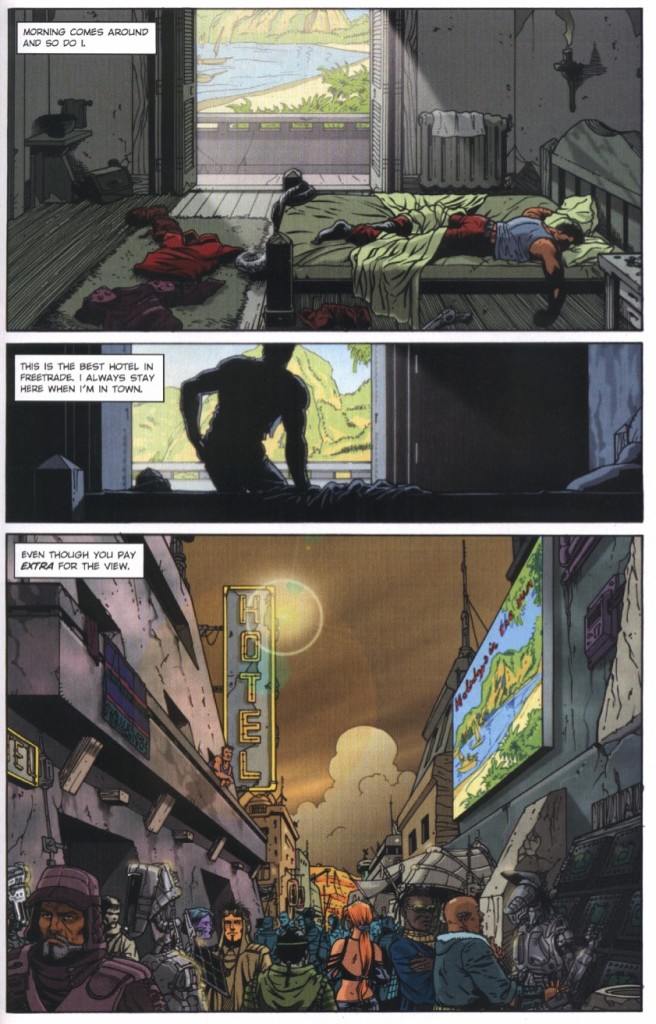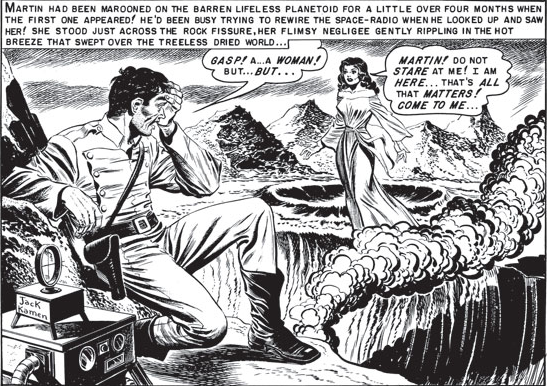I did one of these last month, after watching Annihilation. Now, to celebrate the return of Westworld, I’m spotlighting another half-dozen underrated sci-fi comics:
OCEAN
It’s a testament to Warren Ellis’ creative mind and writing skills that Ocean is actually one of his lesser works. This thriller about a UN weapons inspector who is assigned to investigate a bunch of mysterious coffins that show up in one of Jupiter’s moons – and who then goes up against a sinister Microsoft-like corporation doing secret research in space – is a masterclass of lean storytelling and worldbuilding. While relying on generous stretches of dialogue to deliver key exposition, the comic also conjures up a believable future based on subtle reactions and visuals clues (plus, the characters’ gender and ethnicity give you a hint of social progress). There are heady sci-fi ideas and even a satirical bent in the form of a group of remote-controlled ‘corporate humans’ (‘When people are hired on, their own personality is shut off for the duration of the work contract.’).
It can sometimes be a disservice to say that a comic feels like a movie, but that’s certainly what the creators were going for here. Ocean is basically the culmination of a string of standalone projects Ellis did in the early 2000s (Global Frequency, Orbiter, Switchblade Honey, Mek, Tokyo Storm Warning, Ministry of Space) where he perfected the art of the film-like sci-fi yarn, balancing technobabble with visual awe. The gifted duo of Chris Sprouse and Karl Story then captured the sense of wonder of the vast Jupiter landscapes and nailed the cinematic rhythm while giving the whole thing even more of a Hollywood vibe by casting a Samuel L. Jackson-esque lead.
In fact, with all the craft that went into this comic, it may sound odd to charge it with lack of ambition, but I still wish it would’ve aimed higher… Ellis relies too much on shorthand characterization (as usual, done over snarky quips about coffee or boredom) and quickly wraps up the plot with a violent shoot-out plus a last-minute escape from an explosion – a pretty by-the-numbers resolution for such a promising set-up!
So yes, Ocean does feel like a cool movie. Yet it feels like one of those cool movies (like Sunshine, District 9, and 10 Cloverfield Lane) where an imaginative high concept ends up drowned – rather than enhanced – by loud action and special effects.
POLSTAR
Speaking of action movie-like comics, the French series of graphic novels Polstar (by the father-son team of Jean Léturgie and Simon Léturgie) reads like a trashy celebration of every cyberpunk blockbuster you’ve ever seen, only with the ultra-violence ramped up to eleven.
Set in 2060, at the heart of a totalitarian empire ruled by a sadistic triumvirate, the first three books tell the outrageous revenge story of a schlubby cab driver – Nicolas Polstar – who goes on a rampage after the brutal murder of his family (including an incubator which he considers his mother). The murder was a set-up designed to frame a revolutionary leader called ‘Le Mérou’ (The Grouper). A computer glitch led the triumvirate to believe Polstar was the right man to take out the Grouper, but they end up getting way more than they bargained for… Before the story is over, this short-sized, big-nosed, psycho anti-hero not only eviscerates more people than Beatrix Kiddo, he also teams up with a deranged cannibal, a traumatized little girl, and a Bruce Willis-lookalike who leads a small army of apes (yes, twelve of them).
There is a nasty strain of cynicism running through the comic. For instance, it is revealed early on that the Grouper was initially the triumvirate’s creation as a strategy to keep the masses in place by giving them a faux champion of justice to channel their hopes of freedom. Moreover, this is one of those tales where the final pages mirror the first ones, leaving you with the impression that, at the end of the day, after all the slaughter and the illusion of political change, the main problems are still there.
That said, nothing here is particularly deep: on top of the derivative setting, the characters themselves are as cartoony as Simon Léturgie’s linework. His art is what keeps Polstar afloat, really – among all the nudity and gore, Léturgie’s dynamic, exaggerated style gives the material a darkly comedic edge, even as the series goes into increasingly tasteless territory. In other words, I could see Paul Verhoeven directing an adaptation of this, but it wouldn’t be half as fun!
The first three volumes came out in the late 1990s and tell a complete saga, which unfortunately has not been translated into English yet. A fourth book came out in 2002, kicking off a new adventure (and sadly undermining the previous book’s finale), but as far as I know the creators haven’t returned to the series since then.
THE SURROGATES
Another dystopic yarn, the 2005 mini-series The Surrogates gives us a futuristic US in which most people stay at home and interact with each other through mechanical substitutes (‘surrogates’). The plot is quite run-of-the-mill for this type of tale: as usual, you have a murder investigation leading you around, with a small case eventually exposing the fabric of the system, including the powers pulling the strings behind the curtain as well as an organized resistance group. We’ve seen this story before, but not this peculiar world – and writer Robert Venditti succeeds in thoughtfully exploring some of the potential implications of such a technological shift in terms of wider society (the backmatter extras are particularly clever).
Although the set-up is not entirely convincing, the point isn’t necessarily to create a credible future as much as to provide a kind of allegory for the present. This belongs in the tradition of literary works like Orwell’s terrifying Nineteen Eighty-Four, Bradbury’s lyrical Fahrenheit 451, and Huxley’s trippy Brave New World – a subgenre that will continue to be reinvented as long there are new trends to engage with (see, for example, Ben Elton’s Blind Faith or any episode of Black Mirror). In other words, even though The Surrogates’ science doesn’t fully hold up, thematically the comic remains pretty topical, as it gives the speculative treatment to trends like online avatars, the mechanization of everyday life, and our culture’s obsession with body image. Seen through that lens, exchanges like the one above, with two hardboiled cops making fun of a guy who uses a female surrogate, come across less as specifically transphobic than as part of the comic’s overall comment on the multiple layers of identity politics – after all, almost everyone in this universe (the cops included) is living through an imagined version of their body, which rarely matches their biological one.
I haven’t seen the film adaptation, but I heard it’s not very good. The movie seems to suffer from Hollywood’s tendency to downplay complex ideas in favor of action and spectacle. Furthermore, it lacks Brett Weldele’s rough-sketch art and monochromatic coloring, which are a big part of The Surrogates’ alluring mood. (Besides the adaptation, there is also a prequel graphic novel, but that’s hardly essential reading.)
THE VISIBLE MAN
After an accident involving radioactive waste, Frank Hart’s skin and surface muscular tissue become transparent, so that you can now see inside his body. Because this is a comic written by Pat Mills, the protagonist may be kind of a jerk, but everyone else around him is even worse… Frank soon realizes that from now on everybody will treat him like a freak – they either fear him, hate him, and/or want to conduct cruel experiments on him.
Although the story meanders somewhat, it’s kept alive by the fast-moving, hysterical script and by the deliberately horrific art (by Carlos Trigo and Montero, with punchy letters by Jack Potter), culminating in a punk-ass, misanthropic finale.
The ‘Visible Man’ saga was originally serialized in 1978, on the pages of the British sci-fi mag 2000 AD. Six years ago, Pat Mills wrote a couple of follow-ups (illustrated by Henry Flint), but they didn’t amount to anything special.
WARDOG
Set in a post-war future populated by cyborgs, sentient robots, and out-of-control military machines, this short-lived series – serialized in the anthology Judge Dredd: The Megazine – followed Jack Wardog, an amnesiac with an explosive charge on his head set to blow up if he didn’t complete his near-impossible missions on time. There was even a timer bonded to Jack’s forehead, counting down to each deadline – that’s how much of a thrill ride this was!
The character and his world were based on a videogame, which is usually an indicator that the comic book team won’t be bringing their absolute A-game to the table… And yet, Wardog was as snappy a two-fisted yarn as they come. Dan Abnett kept things tightly paced and witty, having a lot of fun with the robots’ dialogue by putting a technological spin on familiar human expressions (‘Every night, I try to reboot, but I can’t delete that face from my memory files.’). Patrick Goddard’s and Dylan Teague’s art wasn’t too flashy, it just kept the action clear enough while approaching the weirdest story elements with a deadpan attitude. The same goes for Richard Elson’s colors. Plus, the comic immediately won me over with the opening gag (in the image above).
I, for one, would totally read more Wardog adventures by this creative team.
ZERO HOUR AND OTHER STORIES
For the past six years, Fantagraphics has been putting out a series of excellent collections of EC Comics short stories from the early 1950s (before the institutionalization of censorship through the Comics Code Authority). Each volume revolves around a specific illustrator, his drawings reproduced in black & white – which gives them an amazing noirish quality – and framed between interesting essays. Although not all stories have aged well, the best ones still hold up as masterpieces of the medium. I’m especially fond of the Twilight Zone-ish shockers written by Al Feldstein, even if they tend to be text-heavy, cluttering the work of talented artists with too many captions and word balloons (lettered in typescript font, just to make things worse!).
Zero Hour and Other Stories, which collects comics illustrated by Jack Kamen, may not look as gorgeous as Al Williamson’s 50 Girls 50, or feature as many powerful tales as Joe Orlando’s Judgment Day, or be as sharply satirical as Feldstein’s Child of Tomorrow, but it’s a blast in its own way. Kamen had a clean-cut, sexy style that almost felt like a parody of 50s’ wholesomeness, so of course the folks at EC assigned him the nastiest pieces of black comedy. Scripted by Feldstein and Jack Oleck, co-plotted with Bill Gaines or adapted from the works of Ray Bradbury, some stories have a Cold War vibe (particularly ‘4th Degree’ and the titular ‘Zero Hour’), but they mostly revolve around troubled gender relations, including twisted tales about scientists who use cutting edge technology to run away with their mistresses, horny nuclear war survivors (a trope of the era’s post-apocalyptic fiction, famously at the core of the novel I Am Legend), and greedy lovers whose desire to be together often culminates in a macabre punchline… not to mention the one about the abused wife who inadvertently eats her husband!
Brace yourself for more than a few misogynist stereotypes, like the nagging spouse or the cold-hearted femme fatale. Still, there is something perversely amusing and subversive in the way these comics suggest the dark impulses lurching underneath Eisenhower’s suburban America… even if the collection also contains what is perhaps EC’s tenderest moment, in the form of a tale about an alien invasion (one of many) that gets sidetracked by the aliens’ discovery of emotional and sexual attraction.


